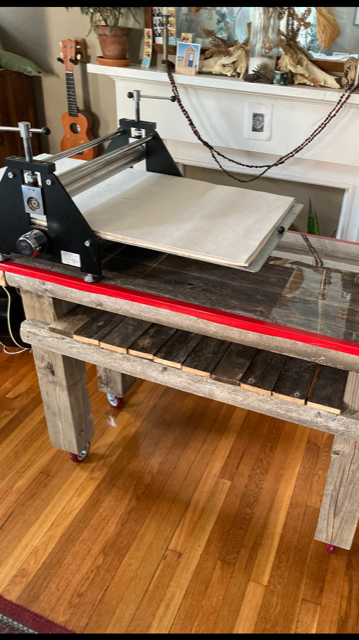Ritual
Jonathan Pinto
“When you trust your gut, you stop thinking with your head and start thinking with your hands.”
Interview by C. VanWinkle
January 29, 2022
Would you please begin by telling me what it was that you responded to?
It was a painting that featured what appear to be Native American, Indigenous dancers, with these ghostly, spirit-like figures emerging from the ground. It reminded me of something I'd seen in the news. I think it was in British Columbia. They found these mass graves of children. I think they were called residential schools, which they would send Indigenous children to and a lot of them died from sickness or mistreatment or abuse. It was this horribly tragic thing. And this beautiful painting was depicting some kind of dance ritual, either in remembrance of these spirits or calling them back.
When I saw the piece, it was an interesting coincidence because lately I have been thinking a lot about, without sounding hokey, spirits and death and other dimensions, energy, all these things nebulously swishing around in my head. Also thinking about what happens to people we care about, or are connected with, after they pass. I found it apropos that I got this piece. At the same time, I also found it really challenging because I could link it to something specific I had seen in the news. At first, I thought, Oh my gosh, does my response need to be that specific about this event, about this culture? I went back and forth and spent a lot of time looking at it and thinking about the movements I was seeing in it, especially the two dancing figures. I thought about dance and ritual in general, so I started making some pieces that felt ritualistic or were depicting a ritual. But I wanted to be kind of vague, a little bit mysterious about what was going on. And that's how I eventually landed on the print that I made.
In addition to dance, when I think of ritual I think of fire or candles or something. Some kind of invocation. I wanted to show some fluidity because the whole painting had so much movement in it, both from the spirits and the dancers. Working with monotypes is a new medium for me, to be honest. What I like about it is it lends itself well to really fluid depictions, and almost ghostly images or things that are more atmospheric. So it all fell together and felt really organic and natural.
Why did you choose this medium? I know you work in others as well.
That's a good question. I was kind of swirling around with some ideas. I was actually thinking about doing a photograph first. I've been doing a lot of Polaroids lately, in addition to monotypes. I was thinking about rituals, and I thought about depicting an altar or something, some kind of representational, symbolic way of communing with ancestry or someone who’s passed. I was setting things up for it, but I just wasn't feeling it for some reason. It just kept getting delayed. I thought I’d just do some other stuff, because one of my art mentors always said that when you're having a little bit of a blockage, just switch gears. Try something else. If you're working in pastels, draw a line with graphite or switch to some paint. Take a break and think about something else entirely. Sometimes it helps. So I started doing some monotyping. I find that the first couple ones generally are warming up, and then the first one that I felt I really connected with was the one that I ended up submitting. I looked back at the painting I received and it just felt right.
I had originally planned on doing a photograph because that's my original medium. It's what I feel the most comfortable with in terms of expressing my thoughts and feelings. But this new medium’s kind of taken a hold of me. I really enjoy hands-on processes of anything. I think it's why I still work in film. You imbue your energy into things. It's also why I have a bunch of objects everywhere in my home, kind of a maximalist hoarder mentality. But it’s because I like a lot of hands-on stuff. We all imbue our energy into the things we create, the things we hold dear.
One of the things I like about printmaking is that it’s very much a ritual in and of itself. You have to set up your plates, you have to set up your paper and soak it. There are steps you have to take, almost like a ritual invocation or something. And then something magical happens, tapping into whatever, whether you're connecting with your own inner creativity like some manifestation of the divine, or some connection you had with somebody else. Whatever you believe creativity is. But there's very much a ritualistic process about it. It wasn't planned but it worked out that way. And it felt very ritualistic, so it all tied together.
What are some things that inspire your work?
Nature is a big one. I'm not really sure if I would consider myself religious or anything. You know, I'm not really sure where my beliefs lie. I’m kind of agnostic. But nature has always felt like a religion to me in a sense. I feel really at peace when I'm out there and so a lot of my photography takes place in nature. Then from my photography, I often get a lot of inspiration to work on my prints or drawings or sometimes even my collage work. I feel like a lot of it always comes back to nature. And then dreams, as well. I find dreams really fascinating. So every once in a while, themes from my dreams will sneak into work, but it's mostly nature.
Does this piece have any influence from dreams?
I don't think this one does in particular. I have been having a lot of strange dreams lately with a lot of birds and movement, so I made some other things that are monotypes of bird shadows. Well, they're kind of amorphous shapes, but they remind of birds.
This particular piece is also dark, maybe bordering on spooky. Also, you live in Salem, Massachusetts. Is there a correlation there or are those unrelated?
[laughs] Maybe a little bit of both. I've always been drawn to the subversive or things that are a little darker. I know some people who are big Halloween and horror fans. I'm certainly not a fanatic by any means. In fact, living here in Salem, I hide out in the month of October. The crowds are a little much for me. But I do think a lot of my work has kind of a darkness to it. I recently showed a bunch of my monotypes to a friend of the family, who is much older and maybe a little more conservative and less familiar with art. She really liked them, and I thought it was funny because at the end she said, “Do you ever make anything that's happy or bright?” [both laugh]
I hadn't really thought about it, but I guess my work has a certain amount of darkness because life and nature have a certain darkness. You know, it's not all beauty and magic. There's also a sadness and a darkness to everything. There's a balance, right? And sometimes the darkness might be a little bit stronger, at least in my own life. I've had certain struggles with mental health issues, and so that might have some influence on my work having a somewhat dark or somber energy to it. But for me, it's always been a way of expressing inner turmoil and using it as a way of catharsis.
That’s beautiful. How else does this piece relate to the rest of your work?
I've been getting into more figurative stuff lately, so it's been an exploration of that. I've been doing some up-close figure studies, but also a lot of figures in the distance or anonymous gestural figures, kind of mysterious in a sense that you don't know what's going on. So I think it ties with some of the other prints I've been making lately in that way.
Do you like to collaborate? Do you do it often?
I haven't done it often. I could count on one hand the number of times I've done it and it's more out of self-consciousness, I guess. Creating has always been a very private thing for me, something that I've always done alone. My studio is actually my living room. It took a while for me to get comfortable creating while my partner was in the background doing his own thing. It’s always been such a private, intimate thing that I never really let anyone into, so collaboration was intimidating to me. I felt like I was being too vulnerable. I think I have only done it a few times with people that I felt really close to. But I would certainly like to get more comfortable with it. And this felt like a nice way to try a different type of collaboration, something I hadn't ever really had any experience with. I was really excited about it.
Was it hard to work from a prompt? Or did that make it easier?
I thought it was challenging at first, for sure. I really struggled with what to do. I was toying around with the idea of photography and something wasn't sitting right with me with the image that I had in my head. Then I thought about doing a combination, like doing an emulsion lift since I was working with Polaroids and doing some kind of collage work around it. I was thinking about all these different things, and I think I was overthinking it. I think since having a prompt was something I wasn't used to, I really, really overthought it. Eventually, I stopped stressing about it and I just let the ritual take over. I thought, You know, I’m going to start tearing the paper. I'm going to start rolling some inks and see what happens. When you trust your gut, you stop thinking with your head and start thinking with your hands, and go out onto the paper, the canvas, the instrument, whatever you’re doing. Once you get to that point, you get into that flow. It took me a while. I definitely overthought it. I'm sure that happens a lot.
Oh definitely. I would very much like to bottle that thinking-with-your-hands serum.
Yeah, a pill or something.
Now that you’ve done it, do you have any advice for someone else who might be approaching this project?
Just do it. [laughs] Don't overthink it and just do it. If you don't like what you create at first, just keep going and worry about it later.
Call Number: C63VA | C66VA.piRi
Jonathan Pinto is an artist living in Salem, Massachusetts. He works in a variety of mediums, including film photography, printmaking, and collage.






